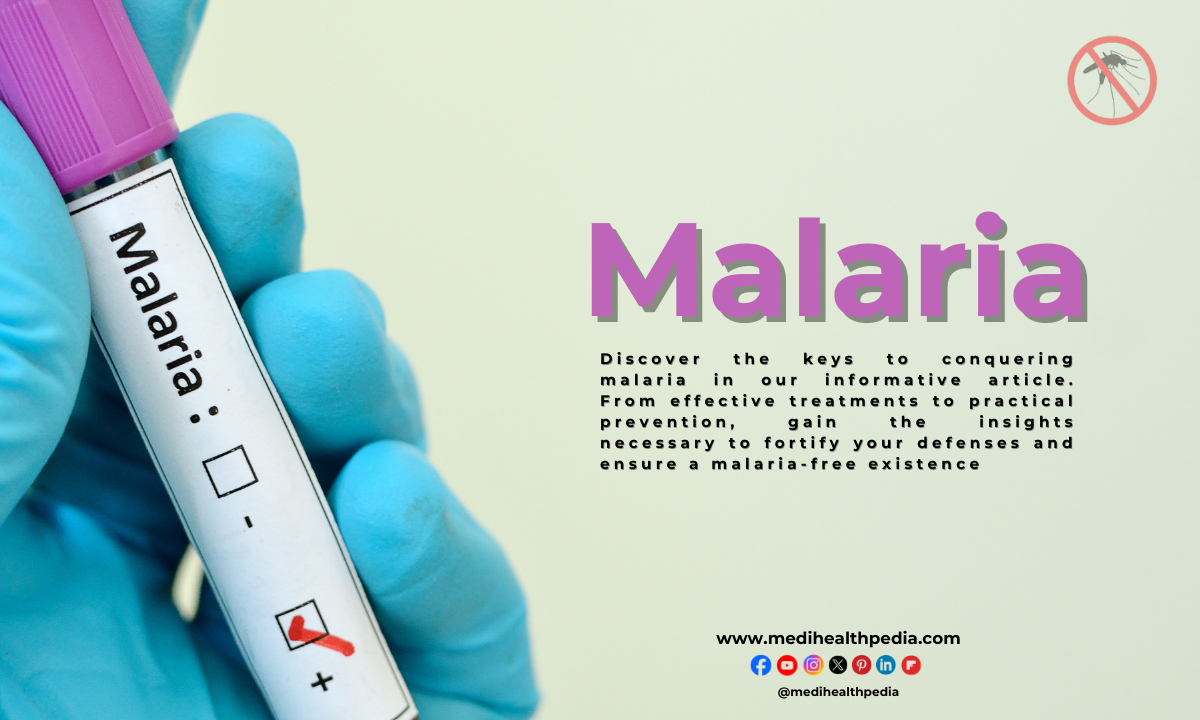What is Malaria? A Comprehensive Guide to Diagnosis, Prevention and Treatment
Table of Contents
ToggleIntroduction
Malarial fever, a mosquito-borne infectious disease caused by the Plasmodium parasite, continues to be a major public health concern worldwide, especially in tropical and subtropical regions. Malaria affects millions of people each year and can have severe consequences if left untreated. In this comprehensive article, we will explore the various types of malarial fever, their clinical presentations, basic investigations, conventional treatment options, preventive measures, herbal remedies, and lifestyle modifications to mitigate the risk of infection.

Types of Malarial Fever
- Malaria is primarily caused by the Plasmodium parasite, and there are several species responsible for the disease. The most common types of malarial fever include:
- Plasmodium vivax (P. vivax)
- Plasmodium falciparum (P. falciparum)
- Plasmodium malariae (P. malariae)
- Plasmodium ovale (P. ovale)
- Plasmodium knowlesi (P. knowlesi)
Each type of malaria parasite can lead to different clinical presentations and complications.
Clinical Overview of Malarial Fever
- Plasmodium vivax (P. vivax):
- Clinical Presentation: P. vivax malaria typically causes recurring fever spikes every 48 hours, known as tertian fever. Patients may experience chills, headache, muscle pain, and fatigue.
- Complications: P. vivax can lead to relapses as the parasite forms dormant liver stages called hypnozoites. These can become active months or years later, causing recurrent infections.
- Plasmodium falciparum (P. falciparum):
- Clinical Presentation: P. falciparum infection can lead to severe symptoms, including high fever, anemia, jaundice, and neurological issues. Patients may develop cerebral malaria, a life-threatening complication.
- Complications: P. falciparum malaria is known for its high mortality rate due to severe complications, especially in children and pregnant women.
- Plasmodium malariae (P. malariae):
- Clinical Presentation: P. malariae causes quartan fever with recurring fever spikes every 72 hours. Symptoms are usually milder than P. falciparum and P. vivax infections.
- Complications: While P. malariae infections are generally less severe, they can persist for years if left untreated, causing chronic health issues.
- Plasmodium ovale (P. ovale):
- Clinical Presentation: P. ovale malaria is similar to P. vivax, causing tertian fever with recurring symptoms.
- Complications: Like P. vivax, P. ovale can result in relapses due to hypnozoites.
- Plasmodium knowlesi (P. knowlesi):
- Clinical Presentation: P. knowlesi malaria is similar to P. falciparum and can lead to severe symptoms. It has a short incubation period.
- Complications: This type of malaria is associated with a rapid progression to severe disease, making it important to diagnose and treat promptly.
Basic Investigations
The treatment of malarial fever primarily involves the use of antimalarial medications. The choice of medication depends on the Plasmodium species causing the infection and the severity of the disease. Commonly used antimalarial drugs include:
- Chloroquine: Effective against P. vivax, P. ovale, and some strains of P. malariae, but not against P. falciparum.
- Artemisinin-Based Combination Therapies (ACTs): These are the first-line treatment for uncomplicated P. falciparum malaria. They combine an artemisinin derivative with another antimalarial drug to enhance efficacy and reduce the risk of resistance.
- Quinine: Used in severe cases of P. falciparum malaria and when other drugs are unavailable.
- Primaquine: Essential for the radical cure of P. vivax and P. ovale infections, as it targets the dormant liver stages (hypnozoites).
Conventional Treatment
Preventing malaria is essential, especially in endemic areas. Effective strategies include:
- Insecticide-Treated Bed Nets: Sleeping under insecticide-treated bed nets can reduce the risk of mosquito bites, particularly during the night when Anopheles mosquitoes, which transmit the parasite, are most active.
- Indoor Residual Spraying (IRS): Spraying insecticides on the interior walls of homes can kill mosquitoes that come into contact with the treated surfaces.
- Antimalarial Drugs for Prophylaxis: Travelers to endemic regions may take antimalarial drugs as a preventive measure. However, these drugs are not suitable for long-term use due to the risk of resistance.
- Environmental Management: Reducing mosquito breeding sites, such as stagnant water, can help control mosquito populations.
Prevention
Preventing malaria is essential, especially in endemic areas. Effective strategies include:
- Insecticide-Treated Bed Nets: Sleeping under insecticide-treated bed nets can reduce the risk of mosquito bites, particularly during the night when Anopheles mosquitoes, which transmit the parasite, are most active.
- Indoor Residual Spraying (IRS): Spraying insecticides on the interior walls of homes can kill mosquitoes that come into contact with the treated surfaces.
- Antimalarial Drugs for Prophylaxis: Travelers to endemic regions may take antimalarial drugs as a preventive measure. However, these drugs are not suitable for long-term use due to the risk of resistance.
- Environmental Management: Reducing mosquito breeding sites, such as stagnant water, can help control mosquito populations.
Herbal Medicines
In addition to conventional treatment options, some herbal remedies have been used for their potential anti-malarial properties. It’s essential to note that herbal treatments should not replace standard medical care, but they may offer complementary benefits. Here are some herbal medicines and remedies that have been studied for their anti-malarial potential:
- Artemisia Annua (Sweet Wormwood): This herb contains artemisinin, a compound used in artemisinin-based combination therapies (ACTs). Artemisia annua has been traditionally used in Chinese medicine to treat fever, including malaria.
- Neem (Azadirachta indica): Neem leaves and oil have shown anti-malarial activity in some studies. Neem is known for its broad range of medicinal properties and is used in various forms for its therapeutic effects.
- Cinchona Bark (Quinine Tree): The bark of the cinchona tree contains quinine, which was one of the earliest effective treatments for malaria. Quinine and related alkaloids have been used in traditional medicine for centuries.
- Ageratum conyzoides (Billygoat Weed): This plant has been studied for its anti-malarial properties and is used in traditional medicine in some regions.
- Papaya (Carica papaya) Leaves: Papaya leaves are believed to have potential anti-malarial properties. Papaya leaf extracts have been used as a remedy for fever in some cultures.
While these herbal remedies have demonstrated anti-malarial potential in various studies, it’s important to approach them with caution. Always consult with a healthcare professional before using herbal treatments, especially if you are experiencing severe malaria symptoms. Herbal remedies should complement, not replace, conventional medical treatment.
Lifestyle Modification
In addition to medical treatment and preventive measures, certain lifestyle modifications can help reduce the risk of contracting malarial fever:
- Use Mosquito Repellent: Apply mosquito repellent to exposed skin, particularly during peak mosquito activity times.
- Wear Protective Clothing: Cover your arms and legs, especially during the evening and nighttime when mosquitoes are most active.
- Eliminate Breeding Sites: Remove stagnant water sources around your home to reduce mosquito breeding sites.
- Seek Medical Care Promptly: If you experience symptoms like fever, chills, and headache, especially after visiting an endemic area, seek medical attention promptly for diagnosis and treatment.
- Stay Informed: Stay updated on local malaria outbreaks and travel advisories if you plan to visit an endemic area.
- Support Malaria Control Programs: Advocate for and participate in community-based malaria control programs, such as bed net distribution and mosquito control initiatives.
Conclusion
Malarial fever remains a significant global health challenge, with multiple Plasmodium species causing a range of clinical presentations and complications. Early diagnosis, appropriate treatment, and effective prevention strategies are crucial in combating this disease.
While conventional antimalarial drugs play a central role in treating malaria, herbal remedies and lifestyle modifications can complement these efforts. Herbal medicines, such as Artemisia annua and neem, have demonstrated potential anti-malarial properties. However, it’s essential to consult healthcare professionals and rely on evidence-based practices to ensure safe and effective treatment.
Preventing malaria requires a multi-faceted approach, including the use of insecticide-treated bed nets, indoor residual spraying, and environmental management to reduce mosquito breeding sites. With a combination of these measures, we can make significant progress in reducing the burden of malarial fever and working toward a malaria-free world.

